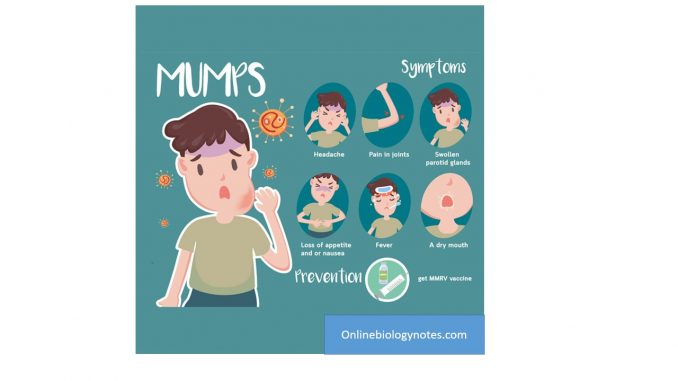
Mumps virus
- Mumps is an acute contagious disease of children, characterized by acute enlargement of one or both salivary glands. The disease is caused by mumps virus. More than 1/3rd of all mumps infections are asymptomatic. It causes a mild childhood disease but in adults complications including meningitis and orchitis.
- Mumps virus is a typical paramyxovirus possessing both HN and F proteins.
- Mumps virus is labile, rapidly inactivated at room temperature or by exposure to formaldehyde, ether or UV.
Mode of transmission
- Infection is transmitted by direct contact, air- borne droplets or fomites contaminated with saliva and also possibly urine.
- Closer contact is necessary for transmission of mumps
- It is difficult to control transmission of mumps because of the variable incubation periods. There are large number of asymptomatic cases and Virus may be present in saliva before clinical symptoms.
Pathogenesis:
- Mumps virus causes a lytic infection of cells and Humans are the only natural hosts
- Once the virus enter the respiratory tract, the infection begins
- The incubation period is typically about 14-18 days (range from 2 to 4 weeks)
- Primary replication occurs in nasal or upper respiratory tract epithelial cells.
- Once viremia occurs, virus is then disseminated to target tissues such as the CNS and salivary glands (parotid gland). Involvement of the parotid gland is not an obligatory step in the infectious process.
- Salivary glands show desquamation of necrotic epithelial cells lining the duct.
- The virus replicates in the target tissues and then causes a secondary phase of viremia.
- The virus then spread throughout the body- to kidneys, testes, ovary, pancreas and other organs.
- Infection of the CNS especially meninges, causes meningitis or meningoencephalitis.
- The CNS is commonly infected and may be involved in the absence of parotitis.
- Mumps is a systematic viral disease with a propensity to replicate in epithelial cells in various visceral organs.
- Virus shed in the saliva from about 3 days before to 9 days after the onset of salivary gland swelling.
Clinical symptoms:
- The clinical symptoms of mumps reflect the pathogenesis of infection.
- At least 1/3rd of all mumps infection are asymptomatic
- Majority of infection occurs in children under 2 years of age.
- The most characteristics feature of symptomatic cases is the swelling of salivary gland which occurs in about 50% patients.
- A prodromal period of malaise and anorexia is followed by rapid enlargement of parotid as well as other salivary glands.
- Parotitis:
- Swelling may be confined to one parotid gland or one gland may enlarge several days after the other gland.
- Gland enlargement is associated with pain and fever.
- Meningitis and meningoencephalitis:
- CNS involvement is common in 10-30 % cases. Meningoencephalitis usually occurs 5-7 days after the inflammation of salivary gland.
- Mumps causes aseptic meningitis.
- Orchitis and Oophotitis mumps:
- The testes and ovaries may be affected especially after puberty.
- 20-50 % of men who are infected with mumps develop orchitis.
- Because of the lack of elasticity of tunica albuginea which does not allow the inflamed testes to swell the complications is extremely painful.
- Oophotitis mumps occurs in about 5 % of women.
- Pancreatitis:
- It is reported in about 4% of cases.
- Deafness:
- It is reported in 4 % cases but last for short period of time
- Complications:
- Arthritis, nephritis, thyroiditis, mastitis, thrombocytopenia, pneumonia, myocarditis, death due to mumps is rare.
Laboratory diagnosis
- Mumps diagnosis is usually clinical, but confirmed by virus isolation and serology.
Specimens:
- Saliva, secretions and CSF and Urine; collected within few days after onset of infection.
- Virus can be isolated from saliva for up to 4-5 days, CSF for about 8-9 days and from urine for about 15 days after the onset of symptoms.
Isolation of the virus:
- The specimen have to be inoculated soon after collection as the virus is labile.
- The prepared specimen is inoculated into monkey kidney cell cultures, human amnion, hela cells or 6-8 days old chick embroys by the amniotic route
- Virus growth can be detected by hemadsorption and identified by Hemadsorption inhibition using specific antiserum.
Serology:
- In this technique 4 fold rise in Antibody titer is the evidence of mumps infection.
- Presence of antibody to V-antigen is indicative of past infection and that of S antigen indicated recent infection.
- Complement Fixation (CF) and Hemagglutination Inhibition (HI) tests are commonly used.
Nucleic acid detection:
- RT-PCR is very sensitive method.
- PCR assay can identify virus strains and provide useful information in epidemiological studies
Treatment and immunization:
- No specific antiviral drugs are available for mumps infection.
- An effective live attenuated vaccine is available against mumps. The vaccine consists of Jeryl- Lynn strain of mumps virus attenuated by serial passage in eggs and chick fibroblasts
- Mumps vaccine is available in combination with measles and rubella as MMR, which is a live attenuated vaccine. The vaccine is given as a single subcutaneous injection.
- Two doses of MMR is recommended for school going children
